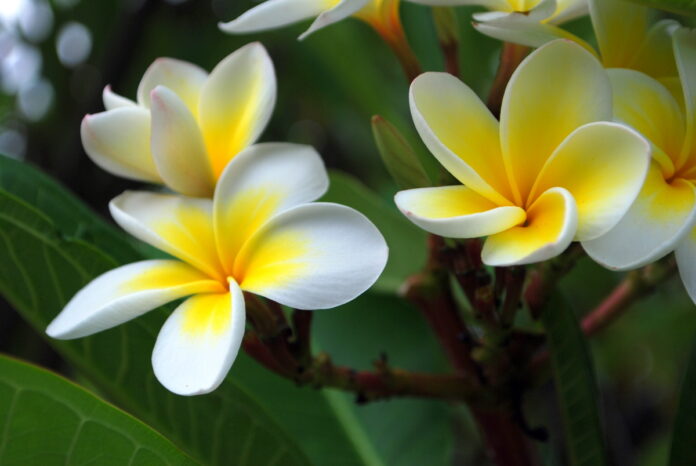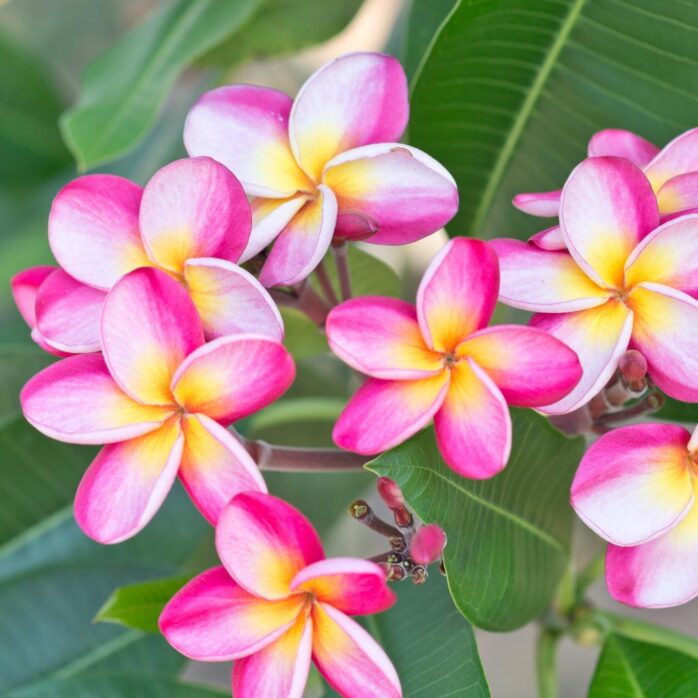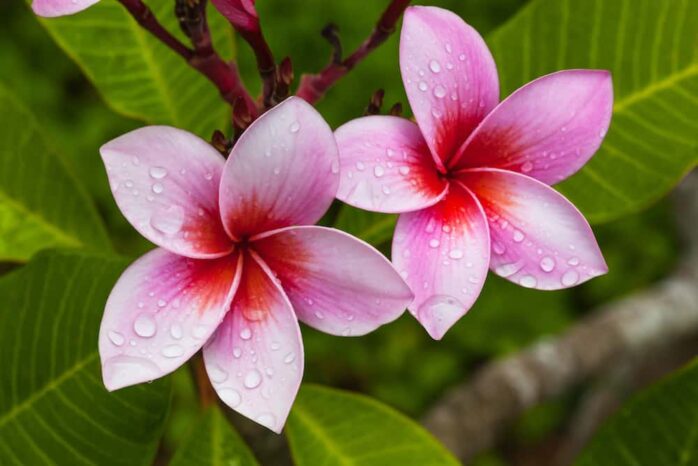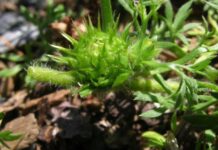
If you are a plant parent, you would know what we’re talking about here. Plumeria is one of the most beautiful additions one might have in their gardens. With its white hues etched by smears of yellow from the inside, it sure is an emblem of simplicity and elegance.
If you are charmed by its beauty too, it would be safe to bet that you might want to own a few of your own.
Read on this article to explore all the possible ways that you can grow and care for your own little Plumeria plant for its longevity and better health. But before diving into all of that, let’s know some basics about Plumeria, shall we?
What is Plumeria?

Well, to start with, Plumeria or Plumeria are small flowering plants. These are small white flowers with a yellow shade in the innermost corners spreading outwards. But that’s just the most common ones. Plumeria can be seen in many other colors as well such as yellows, pinks, and reds.
Found mostly in the tropical regions of the world due to its nativity, these are the same flowers used to make traditional leis in Hawaii. These flowers have an amazing fragrance to them as they bloom majestically from spring through all.
You can easily notice these flowers amongst large-leaved foliage of either evergreen or deciduous depending upon the type of plant.
Growing Plumeria At Home

Now just because Plumeria is locally found in the tropical regions doesn’t mean you cannot enjoy its company in your home garden. You just have to keep in mind a few tips before deciding to take it home so that you are familiar with the growing requirements that are essential for this plant.
Many people use Plumeria to be grown as a small tree or a shrub that ornaments their gardens due to its features.
Plumeria only grows when the soil has a good drainage facility, that is if the soil is well-draining. You might want to consider getting a slightly acidic soil mixture for this particular plant for it to thrive.
One of the non-negotiable things to keep in mind while growing Plumeria is that they need a lot of sunlight. So make sure that it is placed in an area where it receives six hours of direct sunlight at the very least.
Do not worry if your garden is susceptible to salty and windy weather conditions as Plumeria can certainly grow through that. But what it cannot bear is cold weather, so you must find ways to prevent it from dying under colder conditions.
So, if you live in a colder region, you must grow your Plumeria in a container. And if you stay somewhere warm but with cold winters, make sure to dig up your plant and get it somewhere safe and warm during winter.
Other ways of dealing with this would be sinking Plumerias that had been grown in containers to the ground and then bringing them inside when the weather gets wintery and the temperature starts to decrease. And when summer is back again with warmer temperatures, you can take your plant outside again to get some sun.
If you are planning to grow your plant in a pot, make sure that you use a coarse pot mix that is well-draining. Using cactus mix or perlite and sand would do the job quite well in this case.
Caring For A Homegrown Plumeria

Now that you are done with the first part of your work, the rest isn’t that difficult. So, by now you might have planted your Plumeria but what’s next? Next comes taking care of the plant but don’t worry. Plumeria is low maintenance.
Even though most of the plants do not like their roots to be kept wet, make sure that you have watered them deeply enough during the irrigation part. After the soil is dry by absorbing all the water, water it again. It is a very essential part of their growth process.
You also have to feed them enough fertilizer to keep them healthy. Once every two to three weeks should do the job perfectly. Make sure to never miss it during their prime growing seasons.
Watering the plant is only necessary during the summers. Once fall sets in, decrease your watering levels and stop completely once winter arrives, and they enter the dormancy phase. Resume with your watering when spring comes once again and repeat the process.
To encourage the flowering of the plant, you should use phosphate or phosphorus fertilizer in a 10-30-10 way. If you give them excessive nitrogen, it will only boost foliage but will result in fewer blooming activities.
You can even prune your Plumeria up to 12 inches that is 31 cm based on your requirements. You can do this while the flower is still in the ground during late winter or even during early spring.
You can do this before any growth occurs. Make sure to keep it to the minimum as any sort of hard pruning may leave your plant flowerless.
You can propagate these plants through seeds or by cutting them during the spring season. Cutting is actually the most popular and preferred method because of how easy it is to do.
You can then insert these cut-up branches up to 2 inches that are roughly around 5 cm into a potting mix. Then water it properly and repeat the cycle as mentioned above. And voila! You have a new Plumeria plant!

Final Thoughts
With the onset of the pandemic, more and more people are investing their time in gardening and their top choice is Plumeria due to its versatility. The key points to remember while growing such plants would be firstly to select a proper planting area, then planting it during warmer seasons, preparing the soil to be well-drained, planting the Plumeria proper, and then watering it and feeding it at regular intervals.
If you are able to keep these few things in mind, you are good to go. Happy Gardening!






